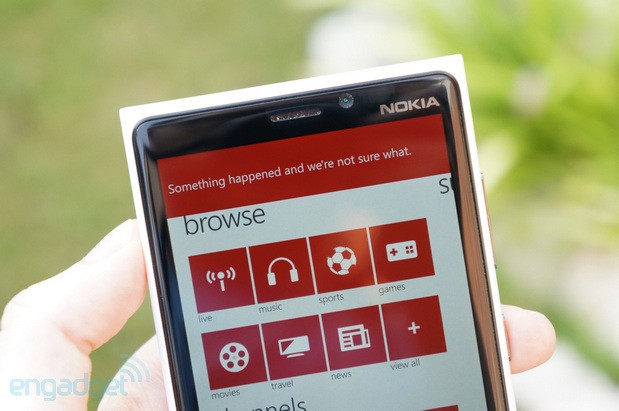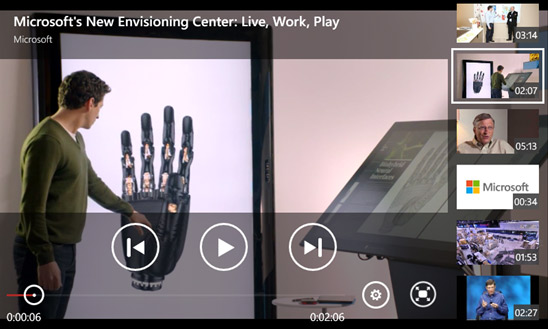Google again blocked the YouTube app for Windows Phone
Microsoft has published a statement under the heading "Open borders of Google." The reason for the publication of this letter was the fact that Google again blocked access to YouTube for a mobile application under Windows Phone .

The first time it happened three months ago, and the cause was numerous violations of Microsoft terms of service use. In particular, the mobile application cut advertising from YouTube and provided users with direct links to download video files from YouTube.
')
After the first blocking, Microsoft entered into negotiations with Google and promised to correct all violations. But Google put forward another requirement: in addition to eliminating violations, the new mobile application must be written in HTML5.
Now Microsoft has released a new version of the application, which two days later was blocked by Google.

Microsoft explains that the HTML5 requirement was initially strange, because neither the YouTube mobile app for the iPhone, nor the Android app is written in HTML5. "However, we have allocated significant engineering resources to explore this possibility," writes David Howard, vice president and deputy chief legal adviser at Microsoft. In the end, experts from both companies recognized that building an HTML5 based application would be technically difficult and time consuming. We suppose that is why YouTube has not yet released such versions of applications for iPhone and Android. ”
“For this reason, we made a decision this week to release a non-HTML5 version of the application, continuing long-term cooperation with Google over the application on HTML5,” Howard writes. He believes that this provides users with the ability to watch YouTube videos in the short term and puts Windows Phone on an equal footing with Android and iOS devices, suggesting a gradual transition to a new technology. Despite this, Google decided to block the application again.
Microsoft suggests that Google’s requirements were specifically designed so that Microsoft could not fulfill them and that Windows Phone users would not have equal opportunities with Android and iOS users.
The formal reason for the blocking is that the application does not always correctly display ads in accordance with the settings of the content owner. But Microsoft explains that the program uses all the metadata it receives from YouTube. The company turned to Google with a request to provide them with metadata, which are transmitted from YouTube to Android and iOS devices, in order to copy the advertising display mechanism there, but Google refused to do so.
In addition, Google reported a violation of the terms of use of the service, without specifying specific items that were violated, expressed dissatisfaction with Microsoft branding in the application for YouTube and insufficient application performance.
“We consider it obvious that Google simply does not want to provide Windows Phone users with the same features that Android and Apple have,” writes David Howard, “and that their objections are nothing but excuses. However, we’re excited to work with Google to satisfy any of their legal requirements. At the same time, we once again ask Google to stop blocking our application for YouTube. ”

The first time it happened three months ago, and the cause was numerous violations of Microsoft terms of service use. In particular, the mobile application cut advertising from YouTube and provided users with direct links to download video files from YouTube.
')
After the first blocking, Microsoft entered into negotiations with Google and promised to correct all violations. But Google put forward another requirement: in addition to eliminating violations, the new mobile application must be written in HTML5.
Now Microsoft has released a new version of the application, which two days later was blocked by Google.

Microsoft explains that the HTML5 requirement was initially strange, because neither the YouTube mobile app for the iPhone, nor the Android app is written in HTML5. "However, we have allocated significant engineering resources to explore this possibility," writes David Howard, vice president and deputy chief legal adviser at Microsoft. In the end, experts from both companies recognized that building an HTML5 based application would be technically difficult and time consuming. We suppose that is why YouTube has not yet released such versions of applications for iPhone and Android. ”
“For this reason, we made a decision this week to release a non-HTML5 version of the application, continuing long-term cooperation with Google over the application on HTML5,” Howard writes. He believes that this provides users with the ability to watch YouTube videos in the short term and puts Windows Phone on an equal footing with Android and iOS devices, suggesting a gradual transition to a new technology. Despite this, Google decided to block the application again.
Microsoft suggests that Google’s requirements were specifically designed so that Microsoft could not fulfill them and that Windows Phone users would not have equal opportunities with Android and iOS users.
The formal reason for the blocking is that the application does not always correctly display ads in accordance with the settings of the content owner. But Microsoft explains that the program uses all the metadata it receives from YouTube. The company turned to Google with a request to provide them with metadata, which are transmitted from YouTube to Android and iOS devices, in order to copy the advertising display mechanism there, but Google refused to do so.
In addition, Google reported a violation of the terms of use of the service, without specifying specific items that were violated, expressed dissatisfaction with Microsoft branding in the application for YouTube and insufficient application performance.
“We consider it obvious that Google simply does not want to provide Windows Phone users with the same features that Android and Apple have,” writes David Howard, “and that their objections are nothing but excuses. However, we’re excited to work with Google to satisfy any of their legal requirements. At the same time, we once again ask Google to stop blocking our application for YouTube. ”
Source: https://habr.com/ru/post/190240/
All Articles